Do you live in a hurricane-prone area?
Do you know how to prepare for an upcoming tropical storm?
After living through multiple hurricanes here in Central Florida, I’ve learned to anticipate and prepare for hurricane season.

Here on our homestead, we have an annual plan for preparing for any potential storm threats. Based on our hurricane experiences, these are my best tips to help you prepare for your next tropical storm, tornado, or hurricane.
Table of Contents
- Understanding the Risks of Hurricanes
- Monitor the Hurricane Forecast
- Secure Buildings and other Structures
- Plan for Livestock and Crops
- Stock up on Essentials
- Make and Implementing an Evacuation Plan
- Riding Out a Storm
- Prepare for After the Storm
- Community Resilience
- Conclusion
- FAQs
- Information & Resources List
Understanding the Risks of Hurricanes
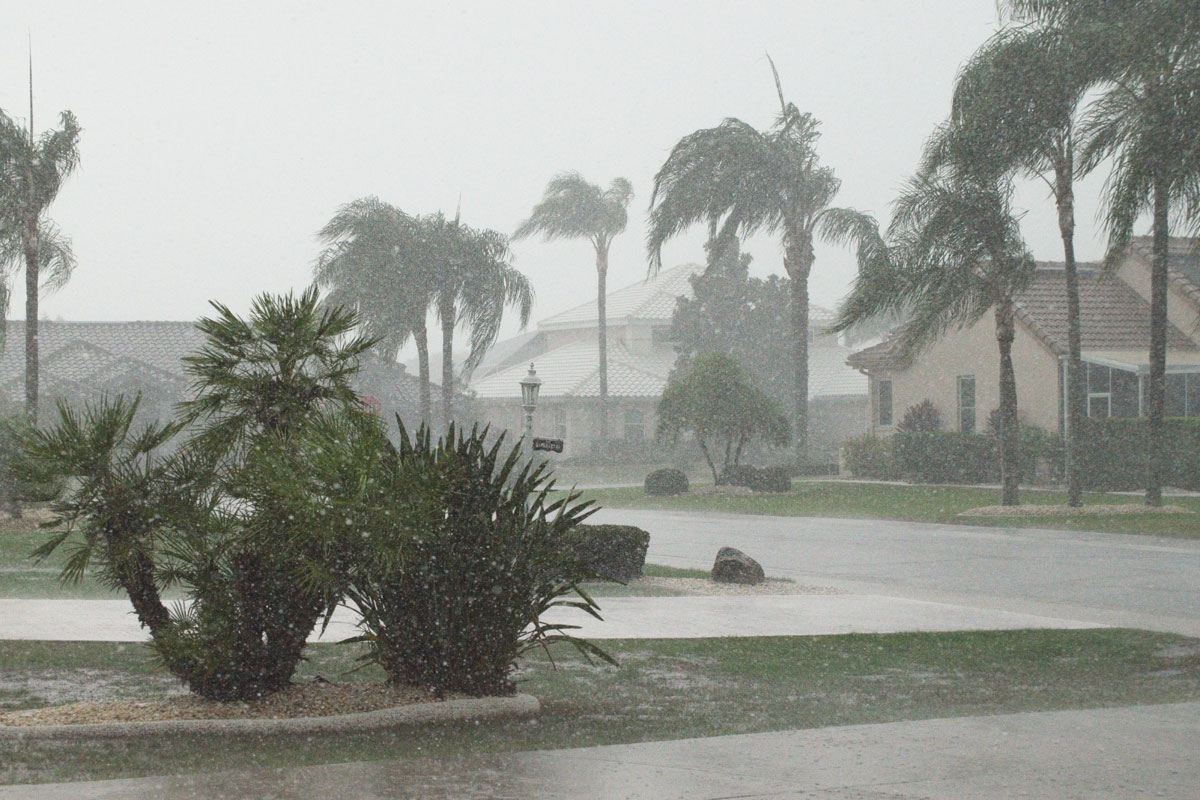
Hurricanes seem to be happening more and more frequently. And the risk of hurricane damage isn’t just related to the coastline. Even hundreds of miles inland, people have experienced flooding, high winds, tornadoes, and torrential amounts of rainfall.
Being prepared for these seasonal storms can help you protect your family, livestock, and property.
Monitor the Hurricane Forecast
As homesteaders, we watch the weather all the time. Our gardens, crops, and livestock depend on our abilities to provide shelter and protection.
If you live in or near a hurricane-prone region, make sure to know when hurricanes are active. Here in the Southeastern United States, our hurricane season begins June 1 and ends November 30th. If you live elsewhere, even inland a few hundred miles, determine if you are at risk by visiting Ready.gov. They have a regional map to help you locate high-risk areas around the country.
Hurricanes can move fast. Use local news sources for the best accuracy to determine if a hurricane is approaching your homestead. During an extreme weather event, officials will send out information via radio, tv, cell phones, and even social media.
If you live in an evacuation area, officials may send out warnings to evacuate or other special instructions. Keep your phone, radio, or other news source close as a hurricane approaches. Download the FEMA app here for instant alerts and text message warnings and information.
Secure Buildings and Other Structures
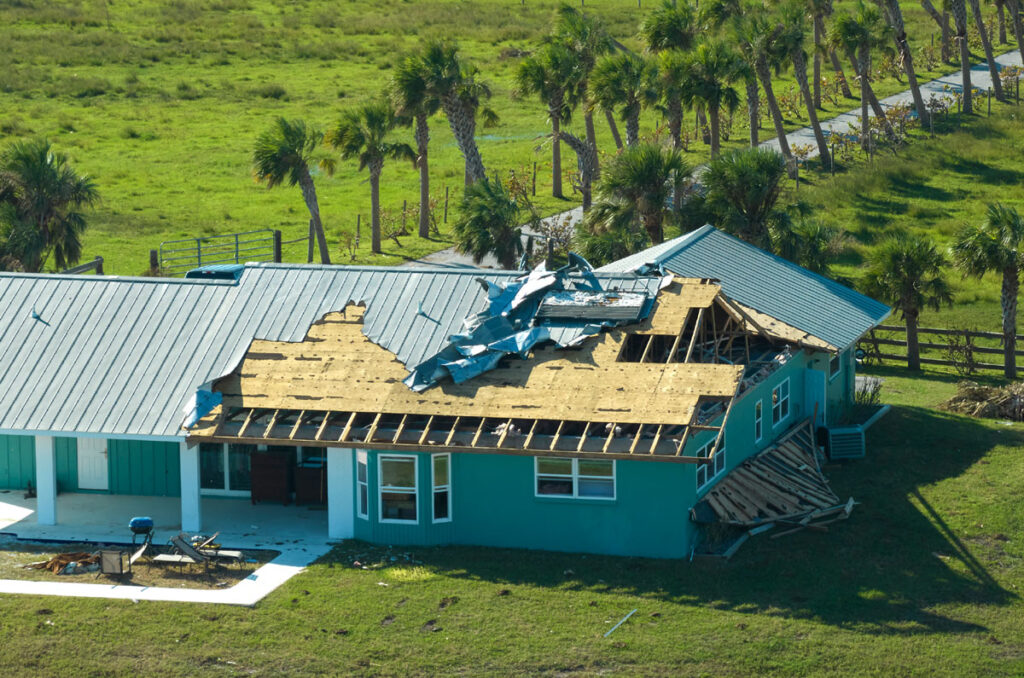
As part of your homestead maintenance plan, you should secure buildings and other structures weeks in advance of hurricane season.
Here are other necessary tasks to protect your homestead:
- Keep trees trimmed around your home and buildings.
- Reinforce any siding, fencing, or weaker outbuildings.
- As the hurricane approaches, clean up loose items around your property such as buckets, tools, and outdoor furniture.
- Secure doors and have protection for windows. These areas are usually the most vulnerable to wind gusts.
- Protect machinery, vehicles, and other tools or supplies.
- Understand where extreme amounts of water will flow across your homestead. Prepare those areas for possible flash flooding.
Plan for Livestock and Crops

For some of us, our livestock are our livelihood. Whether small livestock like chickens or larger animals such as cattle or horses, it’s imperative that we protect our livestock and give them the best chance of survival during a hurricane.
If you are fortunate enough, you may have a safe place to transport your animals before a storm arrives. Often, however, homesteaders are left to prepare as best they can.
Here are some important steps for taking care of your livestock before a hurricane or major storm approaches.
- Make sure everyone has a safe place with protection from high winds and flooding. This may include securing barns or other shelters for smaller livestock.
- Know where potential flooding may occur on the low spots of your property and keep animals out of that area. Many larger livestock such as cattle, goats, or sheep, are better off in a large open pasture and can manage a storm fairly well by themselves. Having both a high area to avoid flooding and a lower area to shelter during a windy storm is ideal.
- If possible, enclose the livestock in permanent fencing. Temporary fencing may blow over, and electric fencing may lose its charge during the storm. Consider removing barbed wire from any fencing that may uproot during a high wind.
- Provide additional feed and water before the storm. If you evacuate, your animals may go several days to a couple of weeks without you to care for them. Or, you may be without power for that same amount of time.
- Just like humans, animals can go several days without food, but not water. It’s essential to have a good water supply for them during a storm. Having a back-up generator, hand-pump, or solar well can save time and physical labor when taking care of everyone after the storm. Make sure any equipment is operational ahead of time.
- Store extra feed securely with the animals or near them. Debris from the storm or flooded areas may make it difficult to get to them for care and feeding. Have at least a 2-week supply of feed, essential medication, and first-aid stored in waterproof containers.
- Make sure all vaccines and other medical records are secured in a safe and dry location.
- Every animal should have some sort of ID in case they escape during the hurricane. Use forms of identification such as microchips, tattoos, branding, or fetlock ID bands. Take pictures of your animals.
- If you feel you must evacuate your animals, do so at least 72 hours in advance of the storm. Once winds reach over 40 mph, you may be turned back by police on the evacuation route when transporting them with a trailer. If you’re unsure, contact your local police department for their recommendations.
Make a plan for your plants too.
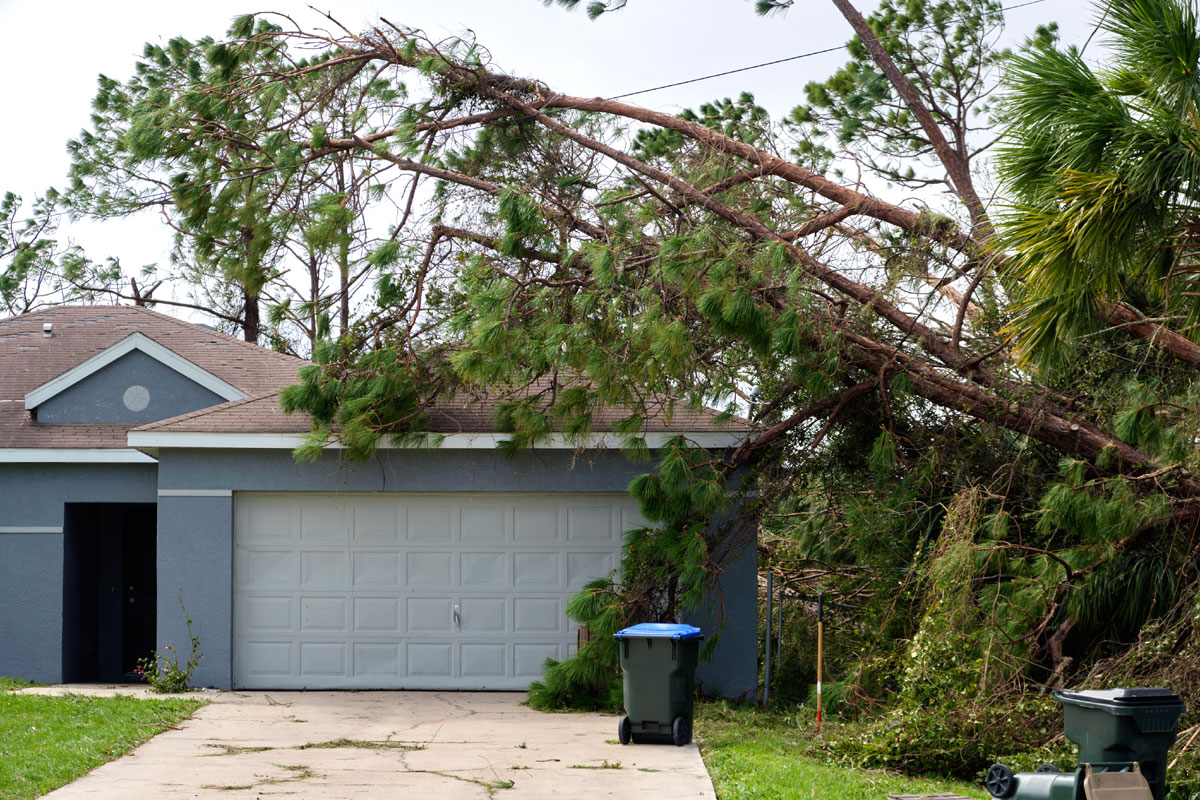
Good garden and orchard management is key to mitigating damage during a hurricane. Some of these tasks you can do as you design your landscape, others just need to be done directly before a storm arrives.
Here’s a quick checklist of things to do to prepare your garden, orchard, food forest, and landscape for a hurricane.
- Regularly prune dead, dying, or diseased limbs from trees.
- Plant trees in groups – they can support each other during high winds and entangled roots can hold each other in place.
- Don’t plant large trees close to your house or other buildings.
- Stake young trees or shrubs that may break instead of bending during high winds.
- Design your garden with good drainage in mind. Use swales or consider planting in raised beds in low-lying areas.
- If possible, lay trellises down. Some vining plants are pliable enough to attempt this. Weigh them down with rocks or some heavier objects being careful not to crush the plants.
- Add more mulch around the plants. This will protect the soil from torrential downpours and erosion.
- Cover smaller plants with buckets held down with a heavy brick or rock on top.
- Move beehives to a sheltered area.
- Remove items from the garden such as hoop tunnels, gardening tools, buckets, or any objects you believe high winds could blow away.
- Put potted plants inside a building that is secured from the storm.
- Harvest crops early if possible.
Stock up on essentials.
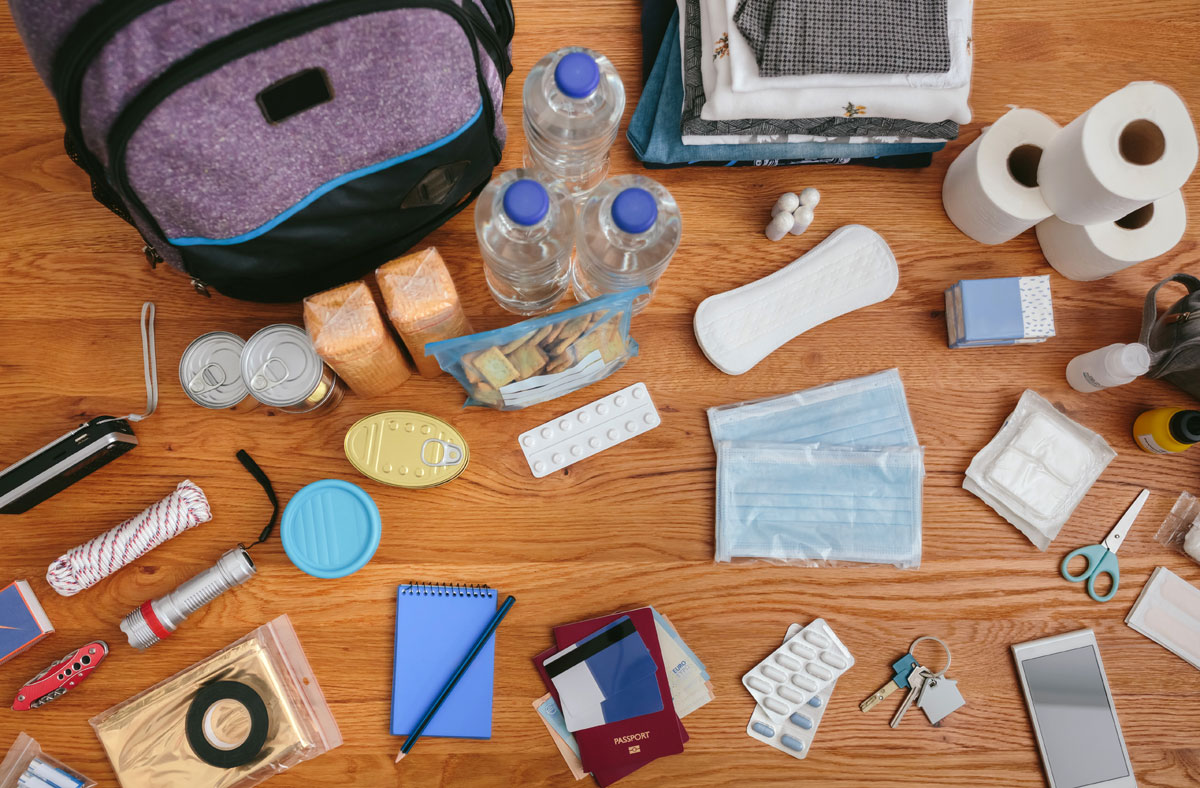
During hurricane season we keep additional essentials in stock such as extra non-perishable foods, bottled water, batteries, fuel for the generator, medicine, and several well-stocked first-aid kits.
Every homestead has their own unique needs. You can learn how to make your own Disaster Supplies Kit at Ready.gov/kit.
Make An Evacuation Plan

If you feel the need to leave your homestead during a hurricane, or if you’re ordered to evacuate by authorities, it’s best to have a plan in place even before hurricane season arrives.
Every year review your evacuation plan and note any changes or improvements you may need to make regarding who is evacuating with your or where your destination is located.
Follow these steps for making and implementing an evacuation plan.
- Determine if you actually need to evacuate. At what point during the storm will you leave?
- How far would you need to travel to avoid the storm? Do you have a dedicated safe place to stay or one or two other alternate locations?
- Are there people with special needs in your family? This Ready.gov/disability web page can help you make appropriate plans. Make sure everyone understands the evacuation plan.
- If you have pets, are they coming with you? Does your safe place accept pets? Is your pet microchipped? Plan to bring enough food and bottled water for them, a safe carrier, and favorite toys to calm them.
- If you are evacuating livestock, have that planned out and accomplished at least 72 hours before the hurricane approaches. Prepare food, water, medicines, halters, and other necessary items ahead of the trip. Make sure the animals are used to being loaded in a trailer. Keep your trailer in good condition, check the lights, and keep a spare tire and tire changing kit on board.
- Map out your route using your state’s designated evacuation routes. Always plan an alternate route. Vehicle accidents and crowded roads can often delay or sidetrack your original plans.
- Review your insurance policies before the hurricane. Make any adjustments needed if time allows. Just like for any natural disaster, take pictures of the inside of your home and your possessions. Save the photos and a list of valuable items to the cloud or other digital location not on your homestead.
- Stay in contact with all family members. Make sure everyone knows where your safe shelter will be just in case you get separated. Contact family or friends outside the hurricane zone to let them know your travel plans.
- Fill you gas tank ahead of time. Gas stations often run out of fuel and close before a storm, or may be without electricity to for the pumps.
- Make sure you have an emergency kit in your vehicle, food, and bottled water in case you get stuck in traffic. Bring extra cloths and protection from the weather such as a rain jacket and boots.
- Are there irreplaceable items you may need to take with you or secure such as important documents, specialized tools, or family heirlooms?
- Just before you leave, check on your livestock. Lock your doors and windows. Unplug electrical equipment except freezers and refrigerators. Call someone outside the hurricane zone to let them know you’re on your way.
- Follow the route you planned. Watch for road hazards such as washed-out roads and downed power lines. Be patient with others. You’re all trying to get to safety. Call family and friends when you arrive to let them know you’re safe.
Riding Out the Storm
It’s a scary time when a hurricane approaches. Try to keep everyone somewhat calm. Listen to the radio, retell happy stories, play a game, or play with your pets. Simple distractions can help ease any tensions.
Here are a few quick tips for riding out the storm after you’ve prepared everything outside your home.
- Make sure phones and necessary devices are charged. Just before the storm arrives, unplug all unnecessary electronics to protect against surges.
- Turn your freezer and refrigerator to their lowest settings a day before the storm. If the electricity goes out, they’ll stay cold longer.
- Select an interior room as a “safe room.” Bring in blankets, pillows, maybe a mattress or heavy table for protection. Have snacks and bottled water handy too. Bring several flashlights and extra batteries.
- Fill your bathtub, buckets, or other containers with extra water just in case you can’t pump water into the house when the electricity goes out.
During the worst of the storm as it passes over, stay away from windows and doors. Put on bike helmets if you have them.
After the Storm
When Hurricane Ian passed over us, there was a calm period after several hours of wind and rain. It was the eye of the storm. It felt eerie, calm, and the sky was an unusual color. Thankfully, we understood there was more to come, so after a short time of looking around while experiencing the eye of the storm, we went back inside the house to prepare for more.
The worst of the storm passed over us during the night. And even though the hurricane had been downgraded, it whipped up winds around 2 a.m. and blew over our metal building we had just put up a week earlier.
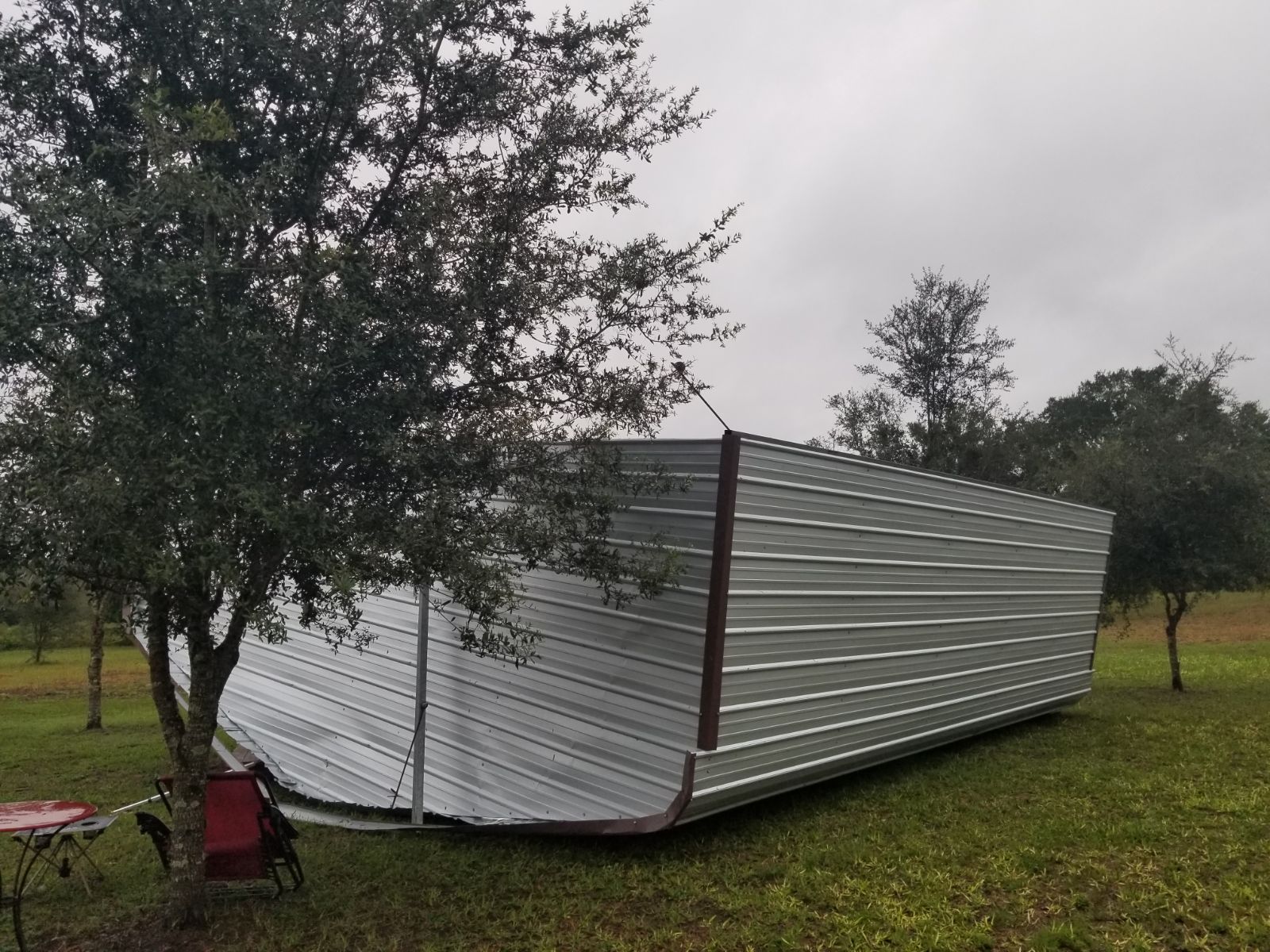
Thankfully, that and a short time without electricity was the worst we experienced with hurricane Ian. Thousands of our fellow Floridians experienced storm surges, flooding, and high wind damage. Unfortunately, some people lost everything.
Here are some last tips for preparing for after the hurricane.
- Have tools ready for cleaning up after the storm. Chainsaws and other tools for cutting tree limbs and debris are essential. Make sure they are full of fuel, sharpened blades, and ready to use at a moment’s notice.
- Larger equipment, like a tractor or truck with chains for dragging large debris can help open up roadways and paths.
- A back-up generator is essential for when electricity goes out. Make sure you have enough fuel stored. Run your generator before hurricane season, keep it full of fuel, and maintain it regularly.
- If you use solar, know that the cloudy days of a hurricane may decrease your supply of power during that time. Plan accordingly for solar energy storage.
- Have on hand tools for quick repairs to damaged fencing, outbuildings, or your home.
Community Resilience
Build community resilience ahead of time. You’ll be there for each other whenever disaster strikes.
Here are 10 ideas for building community resilience.
- Establish good communication channels with neighbors
- Create a neighborhood watch
- Conduct or attend emergency planning workshops
- Create a system for sharing resources
- Create a volunteer network
- Establish mutual aid agreements with neighboring communities and organizations
- Coordinate post-disaster recovery efforts within your community
- Foster community throughout the year by attending local social events
- Regularly communicate with local authorities and emergency management agencies.
In Conclusion
Preparing your homestead for a hurricane takes significant planning and effort, but the peace of mind it provides is invaluable. By understanding what’s at stake, monitoring forecasts, and taking precautions to secure your property, livestock, crops, and supplies, you increase your chances of riding out the storm safely.
Ultimately, being a homesteader means embracing a self-reliant, prepared mindset. This lifestyle demands adaptability, hard work, and the fortitude to withstand nature’s test. Approach the hurricane season with the same determination you apply to all your homesteading efforts.
By preparing properly and emboldening each other, we homesteaders can ride out hurricanes with strength and resilience.
FAQs
Plan for 1 gallon per person/pet per day for 2 weeks minimum. Store larger quantities for larger livestock. Keep purification tablets or filters on hand in case of contaminated water.
Gas generators, solar panel setups, battery banks, and having contingency plans for operating well pumps or other agricultural equipment are good off-grid options.
Yes. Federal disaster relief and crop insurance programs for the USDA may provide aid or low-interest loans for repairs to affected properties. Check with your state also for any disaster relief programs.
Important Information and Resources
Use these websites listed below for more detailed information and available resources.
Great tips. Very informative.